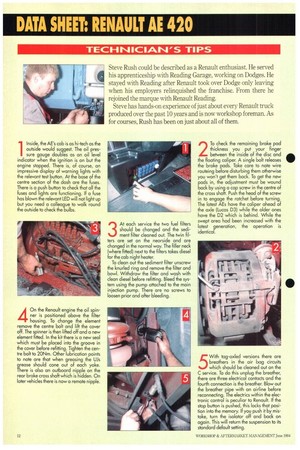Steve Rush could be described as a Renault enthusiast. He
Page 100

If you've noticed an error in this article please click here to report it so we can fix it.
served his apprenticeship with Reading Garage, working on Dodges. He stayed with Reading after Renault took over Dodge only leaving when his employers relinquished the franchise. From there he rejoined the marque with Renault Reading.
Steve has hands-on experience of just about every Renault truck produced over the past 10 years and is now workshop foreman. As for courses, Rush has been on just about all of them.
1 Inside, the AE's cab is as hi-tech as the outside would suggest. The oil pressure gauge doubles as an oil level indicator when the ignition is on but the engine stopped. There is, of course, an impressive display of warning lights with the relevant test button. At the base of the centre section of the dash are the Fuses. There is a push button to check that all the fuses and lights are functioning. If a fuse has blown the relevant LED will not light up but you need a colleague to walk round the outside to check the bulbs. 2 To check the remaining brake pad thickness you put your Finger between the inside of the disc and the floating caliper. A single bolt releases the brake pads. Take care to note wire routeing before disturbing them otherwise you won't get them back. To get the new Dads in, the adjustment must be wound pack by using a cap screw in the centre of the cross shaft. Push the head of the screw in to engage the ratchet before turning. The latest AEs have the caliper ahead of the axle (Lucas D3) while the older ones have the D2 which is behind. While the swept area had been increased with the latest generation, the operation is identical. 3 At each service the two fuel filters should be changed and the sediment filter cleaned out. The twin filters are set on the nearside and are changed in the normal way. The filler neck (where fitted) next to the filters takes diesel for the cab night heater.
To clean out the sediment filter unscrew the knurled ring and remove the filter and bowl. Withdraw the filter and wash with clean diesel before refitting. Bleed the sys tern using the pump attached to the main injection pump. There ore no screws to loosen prior and after bleeding.
4 On the Renault engine the oil spinner is positioned above the Filter housing. To change the element remove the centre bolt and lift the cover off. The spinner is then lifted off and a new element fitted. In the kit there is a new seal which must be placed into the groove in the cover before refitting. Tighten the centre bolt to 20Nm. Other lubrication points to note are that when greasing the UJs grease should cone out of each yoke. There is also an outboard nipple on the rear brake cross shaft which is hidden. On later vehicles there is now a remote nipple. 5 With tag-axled versions there are breathers in the air bag circuits which should be cleaned out on the C service. To do this unplug the breather, there are three electrical contacts and the fourth connection is the breather. Blow out the breather pipe with an airline before reconnecting. The electrics within the electronic control is peculiar to Renault. if the stop button is pushed, this locks that position into the memory. If you push it by mistake, turn the isolator off and back on again. This will return the suspension to its standard default setting.
















































































































